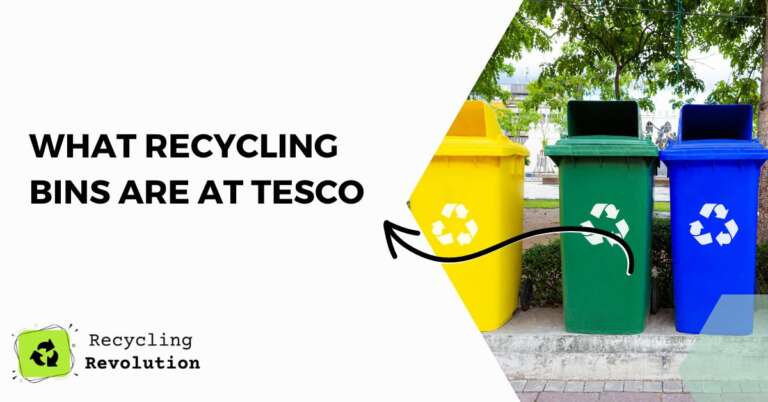Tesco, one of the UK’s leading supermarkets, has shown a dedicated commitment to sustainability by providing recycling facilities at many of its stores.
To make it more effective and easy for consumers, they’ve introduced different recycling bins to cater to various types of waste. From packaging to batteries, there’s a slot for many items that would otherwise end up in a landfill.
TL;DR: In a committed push toward sustainability, Tesco offers a range of recycling bins at their stores for various materials like plastic, glass, cardboard, and batteries. The bins are often color-coded for easy recognition. It’s important to sort your waste accurately to help Tesco do their part for the environment.
What Recycling Bins Can You Find at Tesco?
At Tesco, you’ll typically find the following types of recycling bins:
- Plastic packaging bins: For all your plastic waste, from plastic bags to food wrappers.
- Glass recycling bins: Ideal for glass bottles and jars.
- Cardboard and paper bins: These accept cardboard boxes, paper bags, and other paper waste.
- Can and metal bins: Perfect for disposing of metal cans, aluminum foils, and similar items.
- Battery recycling bins: Specifically for spent batteries.
Remember, these bins are color-coded for easy identification, but it’s always good to check the labels before disposing of your items.
Why Should You Use Tesco’s Recycling Bins?
I recommend using Tesco’s recycling bins for several reasons:
- Environmental responsibility: Every piece of waste recycled is one less item ending up in a landfill. Recycling helps conserve natural resources and reduce pollution.
- Convenience: Tesco’s recycling bins are easily accessible, making it simple for you to drop off your recyclables during your regular shopping trip.
- Broad range of acceptable materials: The variety of recycling bins means you can recycle a wide range of materials all in one place.
How To Use Tesco’s Recycling Bins
Here’s a step-by-step guide to using Tesco’s recycling bins:
- Sort your recyclable waste at home. Separate plastics, paper, glass, cans, and batteries.
- Check for any specific recycling instructions on the packaging.
- Take your sorted waste to Tesco on your next shopping trip.
- Find the recycling area, usually near the store entrance.
- Dispose of each type of waste in the appropriate, color-coded bin.
- Ensure all waste is inside the bin, not left on the floor or the surrounding area.
Note: Please rinse out any containers before recycling to reduce contamination.
Understanding Tesco’s Color-Coded Recycling System
Tesco uses a color-coded system for its recycling bins to simplify the process for its customers. This system aligns with the recycling standards in the UK and makes it easier for customers to identify the correct bin for their waste. Here’s a general guide:
- Blue bins: These are typically for paper and cardboard recycling. Whether it’s an old newspaper or a cereal box, if it’s made of paper or cardboard, it usually goes in here.
- Green bins: Green bins are usually used for glass items. This includes jars, bottles, or any other glass items.
- Brown bins: These are often for garden waste, but in the context of Tesco, they’re often used for plastic waste. These bins take in plastic packaging, plastic bags, and other plastic materials.
- Grey bins: These are for metal items such as cans, foils, and other metal containers.
- Small black or green boxes: These are usually for battery recycling.
Always remember to check the labels as some Tesco stores might use different color-coding.
Deciphering The Symbols
On many products, especially packaging, you’ll find different symbols indicating how you can recycle the item. Understanding these symbols can help you make the most of Tesco’s recycling facilities. Here’s what some common symbols mean:
- The Mobius Loop: This is a triangle made from twisted arrows and it means that the item is recyclable. It doesn’t necessarily mean the item is accepted in all recycling facilities, so do check your local guidelines.
- The Green Dot: This symbol doesn’t mean that the packaging is recyclable, but rather that the producer has made a financial contribution towards the recovery and recycling of packaging in Europe.
- Plastics: Plastics are usually marked with a number in the middle of the Mobius Loop. This indicates the type of plastic, which can affect its recyclability.
Some Insider Tips
To make your recycling journey at Tesco more effective, here are some extra tips:
- Waste segregation is key: Segregate your waste at home according to the type of materials. Not only does it save time when you reach the recycling point, but it also helps prevent contamination of materials.
- Clean it out: Before putting containers in recycling bins, give them a quick rinse. This helps keep the recycling bins clean and avoids attracting pests.
- Check the rules: Always remember to check the specific recycling rules at your local Tesco as they can vary.
Go Beyond Recycling
While recycling is a great step towards sustainability, consider practicing the other two R’s of waste management – Reduce and Reuse.
I recommend reducing the waste you produce by choosing items with less packaging and reusing items where possible before turning to recycling. For instance, you could bring your own reusable shopping bags instead of getting plastic bags each time.
Tesco also supports these practices. In line with reducing waste, they have a ‘Bag for Life’ which can be replaced for free when it wears out.
In terms of reusing, Tesco has partnered with Loop to offer a ‘zero-waste’ online shopping service, where products come in reusable containers that Loop collects, cleans, refills, and reuses.
Exploring Alternatives
While Tesco offers a broad range of recycling options, there might be items that are not accepted in their bins. In such cases, I recommend seeking alternative recycling facilities in your area. Local council websites usually provide information on what can be recycled and where.
Additionally, certain items like electronics, clothes, or larger items may need to be taken to specific recycling centers or donated if they’re still in good condition.
Conclusion
To sum up, Tesco offers a variety of recycling bins for customers to dispose of their waste in an environmentally friendly manner. These bins cater to a range of materials including plastic, glass, paper, metal, and batteries. Not only does this contribute to sustainability, but it’s also a convenient way for customers to recycle while doing their regular shopping.
Remember, the success of recycling depends on accurate sorting of waste, so do ensure you’re placing items in the correct bins. If Tesco’s bins don’t cater to all your recycling needs, don’t forget there are other facilities available to help you reduce, reuse, and recycle.
FAQs
Does Tesco recycle plastic bags?
Yes, Tesco has bins for recycling plastic bags and other plastic packaging.
Where are the recycling bins located in Tesco stores?
The recycling bins are usually located near the store entrance for easy access.
What happens if I put the wrong item in a recycling bin at Tesco?
Incorrect sorting can cause contamination and make the whole bin’s contents unsuitable for recycling. Therefore, it’s essential to put each item in the appropriate bin.
Can I recycle electronics at Tesco?
Currently, Tesco does not accept electronics in their recycling bins. You should look for specific electronic waste recycling facilities in your area.

